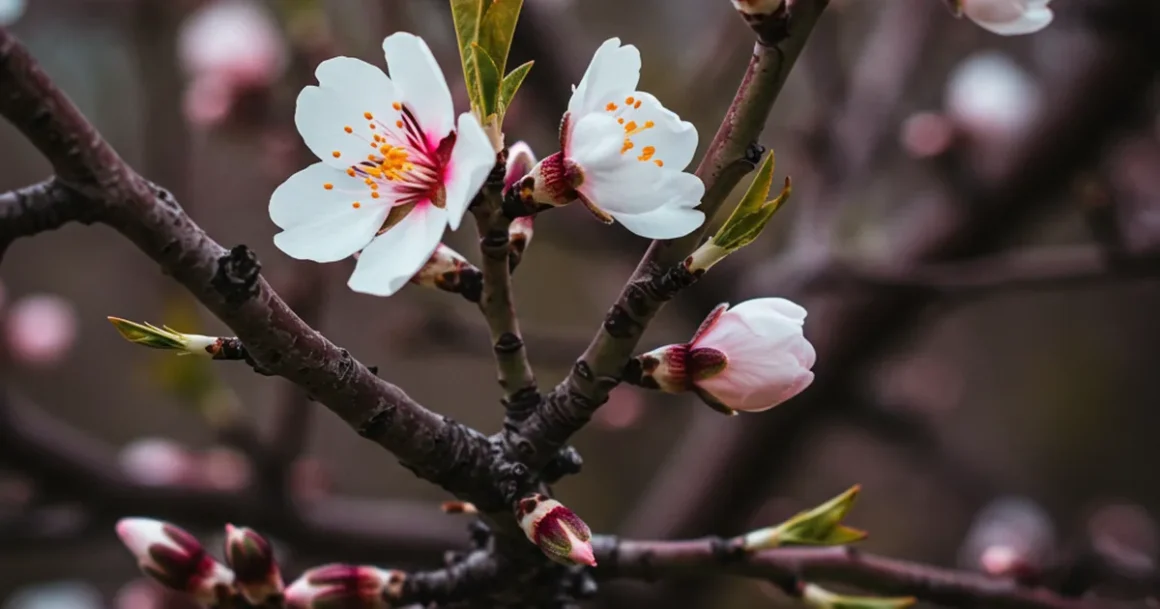Introduction:
There exist various kinds of almond trees, including small ornamental varieties such as the flowering almond, which are cultivated primarily for their beautiful white or pink-tinged flowers in spring, as well as medium-sized trees that yield edible nuts. It typically takes around five years for a tree to grow to maturity and start producing nuts.
Technically, the produce of almond trees is not classified as a nut but rather as a stone fruit (drupe). The fruit that develops on almond trees initially bears no resemblance to the almonds that are eventually consumed. The “nut” is enclosed within layers of a leathery green hull. Within this hull lies a hard, light-colored shell containing a brown seed, which is the almond.
| Common Name | Almond tree |
| Botanical Name | Prunus dulcis |
| Family | Rosaceae |
| Plant Type | Tree |
| Mature Size | 10-25 ft. tall, 10-15 ft. wide |
| Sun Exposure | Full |
| Soil Type | Loamy, well-drained |
| Soil pH | Acidic, neutral, alkaline |
| Bloom Time | Spring |
| Hardiness Zones | 7-9 (USDA) |
| Native Area | Africa, Middle East |
Caring for Almond Trees

The key to successful almond tree cultivation lies in having a suitable climate. Once the right conditions are met, the tree does not demand extensive care.
Light
Almond trees require a minimum of six to eight hours of full sun daily to produce abundant flowers (and potentially nuts).
Soil
The soil should offer excellent drainage and have a pH level between 6.0 and 7.0. Sandy soil is the most suitable, while poorly drained or heavy clay soil is unsuitable for almond tree growth. It is advisable to till the soil deeply before planting to encourage deep root growth.
Water
Adequate water is crucial for almond trees, especially during nut development. Aim for around 3 to 4 inches of water per week, or enough to maintain soil moisture. However, be cautious of overwatering, which can lead to root rot.
Temperature and Humidity
Almond trees have specific temperature requirements. From November to January, they require a minimum of 300 chilling hours with temperatures below 45 degrees F, followed by a long frost-free period, as almonds take seven to eight months to mature. These trees are sensitive to severe cold, and spring frost can harm the flowers.
Summers should be hot with temperatures ranging from 75 to 95 degrees F and low humidity. This is why almond nut production is primarily concentrated in California in the United States.
Fertilizer
Apply a balanced fertilizer to your almond tree in spring. Distribute the fertilizer along the tree’s drip line and refer to the product label for the recommended amount.
Pollination
Most almond trees are not self-pollinating. Cross-pollination requires planting two or more cultivars with overlapping flowering times. Reputable nurseries will provide information on the pollination requirements of the trees they
Different Varieties of Almond Trees

- ‘All-In-One Almond’ is a self-pollinating tree, so only one tree is needed for almond production. It typically grows to a height and width of 12 to 15 feet. This variety blooms late, reducing the risk of damage from spring frosts. Suitable for USDA Zones 6-9.
- ‘Garden Prince’ is another self-pollinating type, reaching a height of 6 to 8 feet, making it ideal for small spaces. Its large pink blossoms in spring add ornamental value. Suitable for USDA Zones 6-10.
- ‘Titan’ is a hardy variety that blooms late and requires another late-blooming tree for pollination. It can grow up to 20 feet tall and is suitable for USDA Zones 5-9.
- ‘Seaside’ (Prunus dulcis ‘Primorskiy’) is a late-blooming almond tree that matures early, reaching a height of 14 feet. While partially self-pollinating, it yields better when planted alongside a different variety for cross-pollination. Suitable for USDA Zones 5-9.
- ‘Nikita’s Pride’ is an exceptionally hardy almond variety originating from Ukraine, growing up to 20 feet tall. Although partially self-pollinating, it becomes more productive when paired with another late-blooming variety. Suitable for USDA Zones 5-9.
Comparison between Sweet Almond Tree and Bitter Almond Tree

Bitter almond trees, scientifically known as Prunus dulcis var. amara, are not as prevalent as Prunus dulcis, the tree known for producing safe-to-eat sweet almonds. Bitter almonds are hazardous due to their high amygdalin content, a natural plant toxin that can lead to cyanide poisoning. The almond trees commonly available at nurseries are all sweet almond trees.
How to Harvest Almonds From Your Tree

Almonds indicate they are ready to be harvested when their hulls start to split open, exposing the light-colored shell. It is important not to delay harvesting once this splitting occurs, as the exposed shell can be easily accessed by birds and insects.
The most straightforward method to collect almonds from the tree is by gently tapping the branches with a pole. To make gathering easier, lay a tarp underneath to catch the falling almonds.
Once the almonds are gathered, they need to be dried properly to prevent molding. The drying process involves several steps:
Steps for Cultivating an Almond Tree in Containers
Almond trees, including dwarf types, are too big to be grown permanently in pots.
Trimming
Trimming an almond tree once a year while it is dormant is crucial for maintaining the tree’s vigor, health, and productivity. Use sanitized pruning tools to eliminate the following:
- Dead or damaged branches, as well as branches that are growing towards the center of the tree
- Limbs, branches, and shoots that obstruct light and airflow from reaching the tree’s core
- Branches that intersect with one another
- Branches that are poorly angled or wide-angled, impeding the tree from growing in an upward direction.
Growing an Almond Tree
The propagation of almond trees is typically done through grafting, a method that guarantees a strong rootstock and the production of top-quality fruits. This process can be challenging for amateur gardeners, so it is recommended to buy a tree from a trusted nursery. Additionally, certain almond tree varieties are copyrighted and cannot be propagated in any way.
Protecting Trees During Winter
To provide the best protection for your tree during winter, consider planting an almond variety that is suitable for the winter conditions in your specific growing zone. Opt for a variety that blooms late to reduce the chances of the blossoms being harmed by a late frost in spring.
Identification of Common Pests and Plant Diseases
Almond farmers in California have identified the navel orangeworm, the larvae of a small moth, as the most damaging threat to their crop. These pests bore into the almonds and consume them. To prevent infestations, it is crucial to eliminate any mummy nuts (those that remain on the tree post-harvest) during the fall or winter. Additionally, applying insecticides specifically formulated to target navel orangeworms is recommended.
Leafrollers are another concern for almond trees as they consume the buds. Furthermore, farmers should be vigilant for aphids and scale insects that excrete honeydew, attracting ants to the tree. In dry conditions, watch out for white webs created by spider mites and remove them by spraying the tree with water.
Almond trees are prone to various fungal diseases, with infections like canker posing a risk of killing the tree. Fungal issues such as anthracnose and leaf spot can be managed through the application of fungicides.
FAQ
When does an almond tree start to produce fruit?
It may take up to five years or more before an almond tree begins bearing almonds. Once it starts producing, an almond tree typically has a lifespan of around 25 years and will yield nuts continuously if properly tended to.
Why do growers shake almond trees?
The initial step in harvesting almonds involves shaking them off the trees. Farmers utilize machinery known as shakers to dislodge the shelled almonds, causing them to fall to the ground where they will dry for approximately a week. After the shells are dried, a sweeper collects the nuts for further processing.

